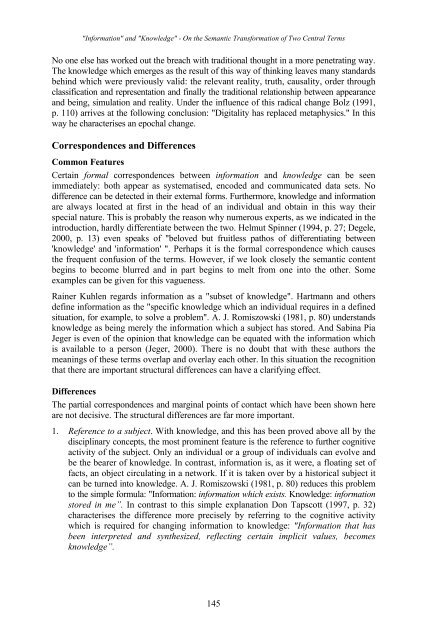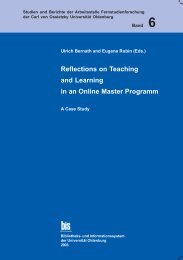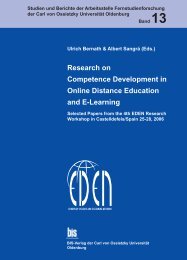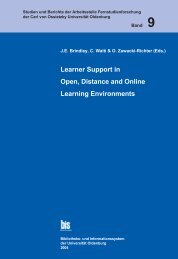Distance Education in Transition - Master of Distance Education ...
Distance Education in Transition - Master of Distance Education ...
Distance Education in Transition - Master of Distance Education ...
Create successful ePaper yourself
Turn your PDF publications into a flip-book with our unique Google optimized e-Paper software.
"Information" and "Knowledge" - On the Semantic Transformation <strong>of</strong> Two Central Terms<br />
No one else has worked out the breach with traditional thought <strong>in</strong> a more penetrat<strong>in</strong>g way.<br />
The knowledge which emerges as the result <strong>of</strong> this way <strong>of</strong> th<strong>in</strong>k<strong>in</strong>g leaves many standards<br />
beh<strong>in</strong>d which were previously valid: the relevant reality, truth, causality, order through<br />
classification and representation and f<strong>in</strong>ally the traditional relationship between appearance<br />
and be<strong>in</strong>g, simulation and reality. Under the <strong>in</strong>fluence <strong>of</strong> this radical change Bolz (1991,<br />
p. 110) arrives at the follow<strong>in</strong>g conclusion: "Digitality has replaced metaphysics." In this<br />
way he characterises an epochal change.<br />
Correspondences and Differences<br />
Common Features<br />
Certa<strong>in</strong> formal correspondences between <strong>in</strong>formation and knowledge can be seen<br />
immediately: both appear as systematised, encoded and communicated data sets. No<br />
difference can be detected <strong>in</strong> their external forms. Furthermore, knowledge and <strong>in</strong>formation<br />
are always located at first <strong>in</strong> the head <strong>of</strong> an <strong>in</strong>dividual and obta<strong>in</strong> <strong>in</strong> this way their<br />
special nature. This is probably the reason why numerous experts, as we <strong>in</strong>dicated <strong>in</strong> the<br />
<strong>in</strong>troduction, hardly differentiate between the two. Helmut Sp<strong>in</strong>ner (1994, p. 27; Degele,<br />
2000, p. 13) even speaks <strong>of</strong> "beloved but fruitless pathos <strong>of</strong> differentiat<strong>in</strong>g between<br />
'knowledge' and '<strong>in</strong>formation' ". Perhaps it is the formal correspondence which causes<br />
the frequent confusion <strong>of</strong> the terms. However, if we look closely the semantic content<br />
beg<strong>in</strong>s to become blurred and <strong>in</strong> part beg<strong>in</strong>s to melt from one <strong>in</strong>to the other. Some<br />
examples can be given for this vagueness.<br />
Ra<strong>in</strong>er Kuhlen regards <strong>in</strong>formation as a "subset <strong>of</strong> knowledge". Hartmann and others<br />
def<strong>in</strong>e <strong>in</strong>formation as the "specific knowledge which an <strong>in</strong>dividual requires <strong>in</strong> a def<strong>in</strong>ed<br />
situation, for example, to solve a problem". A. J. Romiszowski (1981, p. 80) understands<br />
knowledge as be<strong>in</strong>g merely the <strong>in</strong>formation which a subject has stored. And Sab<strong>in</strong>a Pia<br />
Jeger is even <strong>of</strong> the op<strong>in</strong>ion that knowledge can be equated with the <strong>in</strong>formation which<br />
is available to a person (Jeger, 2000). There is no doubt that with these authors the<br />
mean<strong>in</strong>gs <strong>of</strong> these terms overlap and overlay each other. In this situation the recognition<br />
that there are important structural differences can have a clarify<strong>in</strong>g effect.<br />
Differences<br />
The partial correspondences and marg<strong>in</strong>al po<strong>in</strong>ts <strong>of</strong> contact which have been shown here<br />
are not decisive. The structural differences are far more important.<br />
1. Reference to a subject. With knowledge, and this has been proved above all by the<br />
discipl<strong>in</strong>ary concepts, the most prom<strong>in</strong>ent feature is the reference to further cognitive<br />
activity <strong>of</strong> the subject. Only an <strong>in</strong>dividual or a group <strong>of</strong> <strong>in</strong>dividuals can evolve and<br />
be the bearer <strong>of</strong> knowledge. In contrast, <strong>in</strong>formation is, as it were, a float<strong>in</strong>g set <strong>of</strong><br />
facts, an object circulat<strong>in</strong>g <strong>in</strong> a network. If it is taken over by a historical subject it<br />
can be turned <strong>in</strong>to knowledge. A. J. Romiszowski (1981, p. 80) reduces this problem<br />
to the simple formula: "Information: <strong>in</strong>formation which exists. Knowledge: <strong>in</strong>formation<br />
stored <strong>in</strong> me”. In contrast to this simple explanation Don Tapscott (1997, p. 32)<br />
characterises the difference more precisely by referr<strong>in</strong>g to the cognitive activity<br />
which is required for chang<strong>in</strong>g <strong>in</strong>formation to knowledge: "Information that has<br />
been <strong>in</strong>terpreted and synthesized, reflect<strong>in</strong>g certa<strong>in</strong> implicit values, becomes<br />
knowledge”.<br />
145





